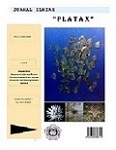The Distribution of Genus Favia (Oken, 1815) at the Reef Flats of Likupang Kampung Ambong Village Minahasa Utara
DOI:
https://doi.org/10.35800/jip.7.1.2019.22597Abstract
Six species of Favia were found in this study i.e, Favia pallida (Dana, 1846), Favia speciosa (Dana, 1846), Favia favus (Forskål, 1775), Favia truncatus (Veron, 2000), Favia rotundata (Veron and Pichon, 1977) and Favia matthaii (Vaughan, 1918). The species with the highest percentage of coral cover was Favia pallida (0,386 %). The values of Dominance Index showed that there were no dominant Favia species on Kampung Ambong coral reef flats. Diversity Index (H’) of Favia was 1,47. There are two distribution patterns shown by Favia on Kampung Ambong coral reef flats area, which are clumped and uniformed.
Keywords: Favia, DistributionÂ
ABSTRAK
Dalam penelitian ini ditemukan 6 spesies karang genus Favia, yaitu Favia pallida (Dana, 1846), Favia speciosa (Dana, 1846), Favia favus (Forskål, 1775), Favia truncatus (Veron, 2000), Favia rotundata (Veron and Pichon, 1977) dan Favia matthaii (Vaughan, 1918). Spesies dengan persentase tutupan karang tertinggi adalah Favia pallida (0,37 %). Nilai Indeks Dominasi menunjukkan tidak ada spesies karang genus Favia yang dominan pada rataan terumbu Kampung Ambong. Indeks keanekaragaman karang genus Favia menunjukkan nilai H’ = 1,47. Terdapat dua Pola distribusi yang diperoleh dari karang genus Favia di rataan terumbu Kampung Ambong, yaitu mengelompok dan seragam.
Kata Kunci : Favia, Distribusi
Downloads
Published
How to Cite
Issue
Section
License
COPYRIGHT
Authors who publish with this journal agree to the following terms:
Authors hold their copyright and grant this journal the privilege of first publication, with the work simultaneously licensed under a Creative Commons Attribution License that permits others to impart the work with an acknowledgment of the work's origin and initial publication by this journal.
Authors can enter into separate or additional contractual arrangements for the non-exclusive distribution of the journal's published version of the work (for example, post it to an institutional repository or publish it in a book), with an acknowledgment of its underlying publication in this journal.
Authors are permitted and encouraged to post their work online (for example, in institutional repositories or on their website) as it can lead to productive exchanges, as well as earlier and greater citation of the published work (See The Effect of Open Access).






































